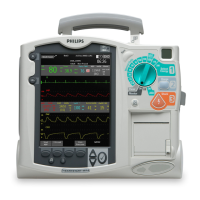93
8
8Pulse Oximetry
Pulse Oximetry (SpO
2
) monitoring is one of the tools available to assist in assessing a patient’s cardiac
and respiratory systems. This chapter explains how pulse oximetry works and describes how to use the
HeartStart MRx to monitor SpO
2
.
Overview
Pulse oximetry is a noninvasive method of continuously measuring functional oxygen saturation
(SpO
2
) in arterial blood. The resultant SpO
2
reading indicates the percentage of hemoglobin
molecules in the arterial blood which are saturated with oxygen.
WARNING Do not rely solely on SpO
2
readings; assess the patient at all times. Inaccurate measurements can be
caused by:
• Incorrect sensor application or use.
• Significant levels of dysfunctional hemoglobins (such as carboxyhemoglobin or methemoglobin).
• Injected dyes such as methylene blue, or intravascular dyshemoglobins such as methemoglobin or
carboxyhemoglobin.
• Exposure to excessive illumination such as surgical lamps (especially those with a xenon light
source), bilirubin lamps, fluorescent lights, infrared heating lamps, or direct sunlight.
The HeartStart MRx allows you to monitor SpO
2
while in Monitor, Manual Defib, and Pacer modes.
When using the Q-CPR option, SpO
2
monitoring functionality is not available.
NOTE For more information on SpO
2
, refer to the Application Note, Philips Pulse Oximetry.

